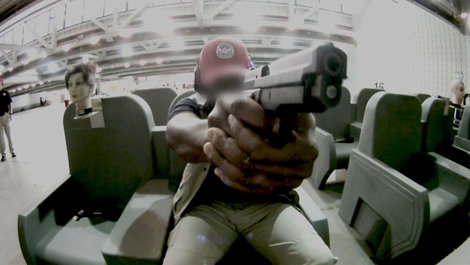The Good Guys – ATF Laws
[su_heading size=”22″ margin=”0″]The Good Guys[/su_heading]
Navigating The ATF’s Labyrinth Of Laws
Story by Alex Kincaid • Photographs by Oleg Volk
[su_dropcap style=”light” size=”4″]T[/su_dropcap]he Bureau of Alcohol, Tobacco, Firearms and Explosives (BATFE, or more commonly referred to as the ATF) is going the extra mile to win your enthusiasm. Check out the agency’s Internet K-9 page, portraying the playful side of the dogs that are responsible for sniffing out the next bomber. You’ll be greeted by a cute and fluffy retriever holding an ATF ball, and while you’re there, click the link to go to the Kids Page with pictures to color and word games. This reminder of your own family is just a click away from pages showing the grim truth of what can happen when firearms wind up in the hands of murderers and drug dealers. The message is clear: It’s a wonderful world – but everything you deem precious could be taken away. The ATF wants you to believe its agents are here to help.

implemented the first tax on machine
guns (like this Browning 1917 machine
gun), short-barreled shotguns and
suppressors.
Despite the failings and negative media exploitation of the ATF as a whole (Waco, Ruby Ridge, Operation Fast & Furious, ammo bans, new gun-trust rules and the enforcement of numerous executive orders come to mind), the individual agents who process our National Firearms Act (NFA) and Federal Firearms License (FFL) paperwork are usually kind, helpful and often sympathetic human beings. Many of them are not anti-gun. I know ATF agents who have served our country through military service, or have operated their own gun-related businesses.
The enlightened gun owner must remember that it was not the ATF that passed the tax act in 1789, or the NFA in 1934, or even the GCA in 1968; Congress did.
The truth is, many gun owners loathe the ATF. Gun business owners fear they will fail to dot an “i” or cross a “t,” and lose their livelihood. Gun owners unabashedly abhor the unrelenting infringement on our constitutional protections by our own government, and many fear they will accidentally commit a felony and face prosecution for their ignorance. One of the ATF’s assistant directors suggested that no matter what side you are on, we can all agree that we do not want the bad guy to have a gun. If we can agree on that, then we’re working together.
The problem, of course, is the law’s ever-expanding definition of bad guy, and what, exactly, constitutes public safety. In the 1920s, public safety meant not allowing hardworking Americans to enjoy a beer at five o’clock. A tax on alcohol in 1789, rather than any criminal activity, gave birth to the agency and it was nestled under the Department of Treasury. While prohibition ended in 1933, the NFA passed Congress in 1934, implementing America’s first tax on firearms and giving this tax-enforcement agency another reason to exist. At that time the NFA imposed an outrageous $200 tax – the equivalent of over $3,526 in today’s value – on gangsters’ favorite firearms: machine guns, shortbarreled shotguns and suppressors (silencers).

controversial components on the market is an arm brace for
an AR-style pistol. However, if used as a shoulder mount, as
seen here, that might turn your simple pistol into a potentially
illegal short-barreled rifle, according to the ATF.
Rather than expect the criminals to obey the law and register firearms – which no one actually expected would happen – Congress intended to remove these weapons from circulation amongst the citizenry by taxing them into infinity. If citizens could not afford them, they could not buy them; if they could not buy them, they could not get into criminal hands. By passing the NFA, our government officially allowed criminals to dictate the interpretation of the 2nd Amendment, and concurrently targeted the firearms possessed by responsible gun owners in a severely misguided effort at crime control.

Today, nothing sends chills down the backs of law abiding gun owners quite like a federal law-enforcement agency specifically trained to spot and apprehend people for violating firearms laws. This chill is not because these gun owners intend to commit crimes – it is because they do not.
Firearms laws are not like speed limits where there are clear signs posted along the highway to tell you what the limitations are and when you might be facing a violation. Instead, gun owners are left to their own devices to sort through the many levels of federal, state and local laws, as well as the ever-expanding interpretations of those laws by the ATF and judges who do not always agree.
The American gun owner suffers from the affliction of so many laws, and most have little, if any, comprehension of all the ways they can run afoul of the imbroglio comprising America’s gun law system. There is no cure for criminal conduct. Once you have violated the law, accidentally or not, you cannot simply undo the criminal behavior. In other words, you cannot give a gun back to the person who sold it to you in another state without using an FFL, and make things OK. I have posed this question to ATF agents, who confirmed that there is no way to undo criminal behavior and make it right. While firearms prohibitionists cannot understand how a person could accidentally commit a crime, it is actually pretty easy to transgress in the world of gun laws and face imprisonment or a hefty fine.
Do you think you own an ordinary pistol?
Take your ordinary pistol (less than 26 inches in length) and add an angled foregrip. You still legally own a pistol. Add a bipod, and you still legally own a pistol.
Add a vertical foregrip, and you have suddenly manufactured a firearm subject to the NFA – which is subject to enforcement by the ATF – that exposes the accidental transgressor to federal felony punishments.
You now own a firearm known as an AOW, or any other weapon. Because the firearm is now subject to the NFA, the gun’s lower receiver must first be registered, or serial stamped and recorded, as an AOW. Registration requires payment of a $5 tax and ATF approval.
Possession of an unregistered AOW is a felony punishable by 10 years in federal prison and up to $250,000 in fines.
If you take the same pistol, but add a full stock to it so it is hen designed to shoot from the shoulder, you have unlawfully manufactured a short-barreled rifle, or SBR. SBRs are NFA firearms as well. The SBR’s receiver must be registered as an SBR, a $200 tax must be paid and ATF approval must be issued before the rifle is manufactured. Possession of an unregistered SBR is also a felony punishable by 10 years in federal prison and up to $250,000 in fines.
Another hot topic is the Sig Arms brace, a device that looks similar to a buttstock, but operates solely as an arm brace, based on the design. Wrap it around your forearm for stability, and you have an ordinary pistol; use it to shoot from your shoulder, and you may have an SBR, according to the ATF.
Did you inherit a collection from your grandfather?
If grandpa brought something back from the war, such as a fully automatic rifle, and never registered that rifle with the ATF, you are in unlawful possession of an NFA firearm.

all types of industrial equipment, only the suppressor designed for use with a firearm has been subject to an extra tax and approval by the ATF since 1934.
Do you think you know whether you possess a machine gun? Did you know that Congress changed the definition of machine gun when it passed the Firearm Owners Protection Act (FOPA) in 1986? Since then, you own a machine gun if you simply own a part “designed and intended solely and exclusively” to convert a weapon into a machine gun. This has come as a shock to some of my clients who have been greeted by ATF agents asking to collect their machine guns. You see, until the 1980s, it was fairly common to purchase a part known as a drop-in auto sear (DIAS), which, when installed into certain AR-style rifles with M16 internal components, would convert the rifle into a fully automatic firearm. Up until 1998, the ATF’s position was that any DIAS manufactured before 1981 was not subject to the NFA. In 1998, however, a federal judge decided that the ATF does not have the authority to make such an exception to the law, and that all firearms dealers “would do well to assume” that any transfers of DIASs are subject to the NFA, regardless of when they were manufactured (United States versus Cash, 149 F.3d 706, CA7 1998).

The problem does not stop with simply having too many laws. It is one task to decipher thousands and thousands of laws that regulate firearms, many of which defy common sense, but it is a completely different task to have to battle the amorphous beast that is the ever-changing American gun-law system. The ATF may make a decision one day and change it the next. This is the same with federal court. A federal court on one side of the country may decide a case one way, and a federal judge in another district may decide differently with a very similar set of facts.
It is no wonder that when most people think about the ATF, they think about rules, restrictions, enforcement of rules against people who didn’t mean to break the law and iron-fisted enforcement of rules that make no sense. If you have the sense that the gun laws that apply to individual gun owners are daunting, think about all the rules, regulations and penalties that apply to gun businesses.
After the assassination of President John F. Kennedy, Attorney General Robert Kennedy and Dr. Martin Luther King, Jr., Congress passed another federal law that I frequently see folks unintentionally violate: the Gun Control Act, or GCA. This law imposed stricter licensing and regulations on the firearms industry, established new categories of firearms offenses and prohibited the sale of firearms and ammunition to felons and certain other persons. This law prevents young soldiers who may sacrifice their lives for our country from purchasing a handgun from a gun shop to defend their own families until they reach the age of 21. It also prevents a gun owner from transferring firearms across state lines without using a dealer. There is no exception for family. If you want to give a firearm to your brother who lives in another state, you must send it to an FFL in his state instead of handing it to him at the Christmas family dinner. If you don’t, you have committed a felony, and so has he.
Gun owners frequently ask if ATF agents actually pursue such cases. The answer is: it depends. Many times, either no one is the wiser or ATF has more important things to do. However, I have been told by ATF agents that they will pursue cases against people who ignorantly violate the law. History also tells us that the ATF has been known to go after the unsuspecting gun owner or gun business owner. After the passage of GCA in 1968, a Senate subcommittee in 1982 concluded that 75 percent of ATF prosecutions “were aimed at ordinary citizens who had neither criminal intent nor knowledge, but were enticed by agents into unknowing technical violations.” The subcommittee’s report supported the passage of the Firearm Owner’s Protection Act in 1986. Compromises to the proposed new law led to some harsh outcomes for gun owners, such as the ban on post-1986-made civilian machine gun sales. This ban was passed despite the fact that over 175,000 machine guns were registered with the ATF at the time, and not a single one had been used in a crime.
Under federal law, the federal government is not supposed to maintain a registry of gun owners. In fact, the FBI is required to destroy background check records for gun purchasers before the start of the next business day. The truth is, the federal government still has several hundred million records of gun owners, including multiple sales reports, trace records and the records of dealers who have gone out of business.
When I asked a former director of industry operations about her opinion of the ATF’s reputation, she explained that the ATF has a difficult job. People are trying to do the right thing, but too often, there are misunderstandings about the laws.
This former director confirmed that people are “on their own” to figure out how to correct gun-law violations. Having sat through my own FFL licensing inspection meeting, I can confirm that it is impossible, in a few hours, for an agent to thoroughly review and educate new gun dealers on the laws. They hit the highlights, ask if you have any questions – questions which most people won’t even know to ask – and check the boxes that they went over a particular law with you and that you had no questions about it.
She also recognized that based on her prior experience working for the ATF, very few people actually intend to break the laws, but there are too many rules and regulations, especially for dealers and manufacturers, to do things perfectly on a daily basis.
I entirely agree with this point. It has been my experience as both a prosecutor and a civil-law attorney that most lawabiding gun owners who have run afoul of the law did so not because they were attacked and had to defend their lives, but because they violated a law they didn’t know existed. The gun laws affecting most gun owners every day are those that pertain to how a person can carry (open, concealed, loaded, unloaded), where they can carry (illegal in a guided federal park cave tour but legal in the open park area), who can
possess a firearm (age restrictions, state law restrictions, permitting restrictions), and how they can transfer a firearm (in state, across states, sale, inheritance) without committing an accidental felony.
At the end of the day, the ATF is charged with public safety and helping gun owners and gun businesses comply with the laws. Many of the agents who work for the ATF try to do just that. The Department of Justice’s direction to the agency, à la Operation Choke Point, an initiative that investigated US banks and the businesses believed to be a high risk for fraud and money laundering, or Operation Fast & Furious, where the ATF purposely allowed licensed firearms dealers to sell weapons to illegal straw buyers, hoping to track the guns to Mexican drug cartel, has recently left a growing section of the public who are disquieted by the motives, character and actions of ATF. The recent proposals for more gun control and the country’s great divide on the protection to be afforded by the 2nd Amendment further enhances this distrust, and keeps the pro-gun community on the defensive.
The enlightened gun owner must remember that it was not the ATF that passed the tax act in 1789, or the NFA in 1934, or even the GCA in 1968; Congress did. If we could just agree on one more thing – what that little word “infringed” really means – we might gain an agency that could focus entirely on its intended purpose, and protect the law-abiding citizens from the true criminals. ASJ
 Alex Kincaid is not only a nationally renowned gun-law attorney, she is also the author of Infringed, where her years of expertise and working with our nation’s laws come together.
Alex Kincaid is not only a nationally renowned gun-law attorney, she is also the author of Infringed, where her years of expertise and working with our nation’s laws come together.




